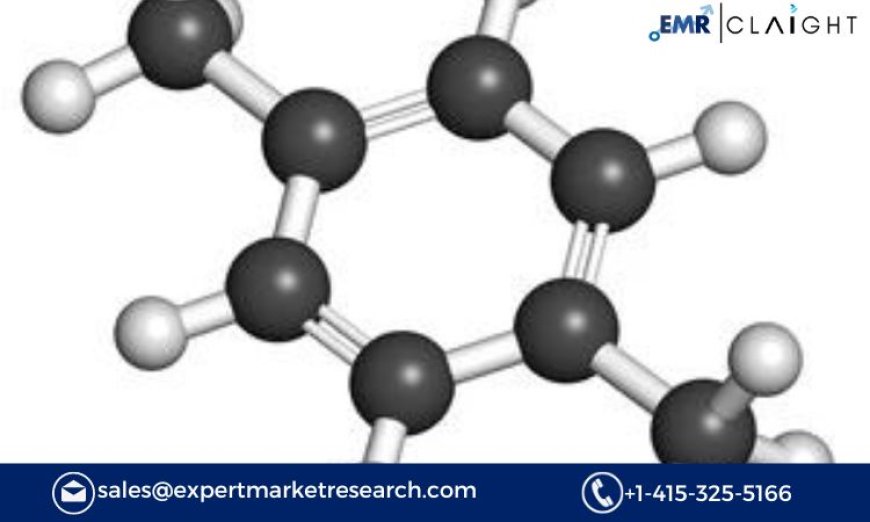Paraxylene Market Size, Share, Growth & Trends | 2032
In 2023, the global Paraxylene Market Size was valued at approximately USD 49.98 billion, and it is projected to grow at a CAGR of 6.4% from 2024 to 2032.

In 2023, the global Paraxylene Market Size was valued at approximately USD 49.98 billion, and it is projected to grow at a CAGR of 6.4% from 2024 to 2032, reaching an estimated value of USD 87.34 billion by the end of the forecast period. The demand for paraxylene is expected to rise due to several driving factors, market trends, and emerging opportunities.
Key Benefits of Paraxylene
Paraxylene offers significant benefits across industries, particularly in the textile and packaging sectors. Here are the primary advantages of paraxylene:
-
Versatile Applications: Paraxylene is used to produce PTA, which is essential in manufacturing polyester fibers, resins, and films. These products are widely used in packaging, clothing, and home furnishings, making paraxylene a versatile raw material in multiple industries.
-
Recyclability: Paraxylene-based PET is highly recyclable, offering an eco-friendly solution in industries where environmental concerns are critical, such as packaging.
-
Growing Demand in Textiles: Polyester fiber, derived from paraxylene, is in high demand due to its durability, cost-effectiveness, and diverse applications in the textile industry.
-
Resilience in Packaging: PET, produced from paraxylene, is widely used in food and beverage packaging due to its lightweight, durability, and resistance to chemicals.
Key Industry Developments
The paraxylene market has witnessed several significant developments in recent years. Some of the key developments include:
-
Expansion of Refining Capacity: Several petrochemical companies have been expanding their refining and PX production capacities to meet rising global demand. For example, major players in China and the Middle East are investing in integrated refinery projects that boost paraxylene output.
-
Technological Advancements: Innovations in paraxylene production processes, such as the development of more efficient catalytic processes, have improved yields and reduced environmental impact. These advancements are enhancing the cost-effectiveness and sustainability of PX production.
-
Shift to Bio-Based PET: The market has seen a shift towards bio-based PET production, which is derived from renewable sources such as sugarcane. This trend is expected to reshape the paraxylene market by reducing dependency on traditional petrochemical sources.
Driving Factors
Several key factors are driving the growth of the global paraxylene market:
-
Rising Demand for PET: The growing demand for PET in packaging, particularly in the food and beverage industry, is a significant driver of the paraxylene market. PET bottles are preferred due to their lightweight nature, durability, and recyclability.
-
Growing Textile Industry: The expanding global textile industry, especially in emerging economies such as China and India, is fueling demand for polyester fibers, which are derived from paraxylene.
-
Urbanization and Industrialization: Increasing urbanization and industrialization, particularly in developing regions, are driving demand for consumer goods, textiles, and packaging, all of which rely heavily on paraxylene.
-
Sustainability Trends: With increasing environmental awareness, the recyclability of PET has become a crucial factor, further bolstering the demand for paraxylene as a key component in sustainable packaging solutions.
COVID-19 Impact
The COVID-19 pandemic significantly affected the paraxylene market, primarily due to disruptions in global supply chains, reduced demand for textiles, and a temporary decline in industrial production. Lockdowns and restrictions on movement affected the demand for PET bottles, particularly in the beverage sector.
However, the market saw a steady recovery as restrictions eased, and industries resumed production. The increased demand for packaging, driven by e-commerce and food delivery services during the pandemic, helped cushion the impact on the paraxylene market. Additionally, the rising emphasis on sustainability and recyclability in the post-pandemic era is expected to further drive demand for paraxylene-based PET products.
Restraining Factors
Despite its promising growth prospects, the paraxylene market faces several challenges:
-
Volatility in Crude Oil Prices: Since paraxylene is derived from crude oil, fluctuations in oil prices can significantly affect production costs, impacting the profitability of PX producers.
-
Environmental Concerns: The petrochemical industry is under increasing scrutiny due to its environmental impact. The production of paraxylene generates carbon emissions, and regulatory pressures on emissions control could constrain the market's growth.
-
Competition from Alternatives: The rise of bio-based and recycled alternatives to PET could potentially reduce demand for traditional paraxylene-derived products. However, the development of bio-based PX may offer an opportunity to mitigate this challenge.
Market Segmentation
The paraxylene market can be segmented based on application, end-user industry, and region.
-
By Application:
- Purified Terephthalic Acid (PTA)
- Dimethyl Terephthalate (DMT)
- Solvents
- Others
-
By End-User Industry:
- Textiles
- Packaging
- Consumer Goods
- Electronics
- Others
-
By Region:
- North America
- Europe
- Asia Pacific
- Middle East & Africa
- Latin America
Market Outlook
The global paraxylene market is expected to witness robust growth over the next decade, driven by increasing demand for polyester fibers and PET products. The Asia-Pacific region, particularly China and India, is expected to dominate the market due to rapid industrialization, urbanization, and growing demand for consumer goods.
Technological advancements in PX production and the shift towards bio-based alternatives are also likely to influence market dynamics. Moreover, growing environmental concerns and stringent regulations regarding emissions are expected to push companies to adopt cleaner and more efficient production processes.
Industry Trends
Some of the prominent trends shaping the paraxylene market include:
-
Increased Focus on Bio-Based PX: Companies are investing in research and development to produce bio-based PX, reducing reliance on traditional petrochemical sources and aligning with sustainability goals.
-
Capacity Expansions: Key market players are expanding their production capacities to meet the growing demand for paraxylene and capitalize on emerging opportunities in the textile and packaging sectors.
-
Rising Adoption of Recycled PET: The trend towards recycled PET is gaining momentum, driven by environmental regulations and consumer demand for sustainable products.
Regional Analysis/Insights
-
Asia-Pacific: This region dominates the global paraxylene market, driven by strong demand from the textile and packaging industries in China, India, and Southeast Asia. The region is expected to continue its dominance during the forecast period due to ongoing industrialization and urbanization.
-
North America: The North American market is expected to grow steadily, with the U.S. being a key contributor due to its well-established petrochemical industry and growing demand for PET in packaging and consumer goods.
-
Europe: The European market is characterized by stringent environmental regulations, which are expected to drive the adoption of cleaner PX production processes. The demand for recycled PET is also rising in this region.
Key Players
Some of the major key players in the global paraxylene market include:
- China National Petroleum Corporation
- ENEOS Corporation
- GS Caltex Corporation
- INEOS Group Holdings S.A
- S-OIL Corporation
- Reliance Industries Limited
- Mitsubishi Gas Chemical Company, Inc.
- Others
Opportunities
The paraxylene market offers several growth opportunities, including:
-
Emerging Markets: The growing middle class in emerging economies is expected to drive demand for textiles and packaging, creating significant opportunities for PX producers.
-
Bio-Based PX: The development of bio-based PX represents a major growth opportunity, particularly as industries move towards more sustainable practices.
Challenges
The market faces certain challenges, including:
-
Environmental Regulations: Compliance with environmental regulations regarding emissions and waste disposal could increase production costs for PX manufacturers.
-
Raw Material Price Volatility: Fluctuations in crude oil prices could impact the cost structure of PX production, leading to market instability.
Restraints
The paraxylene market's growth may be hindered by:
-
Rising Competition from Alternatives: The increasing use of bio-based and recycled alternatives to PET could reduce demand for paraxylene-based products.
-
Sustainability Pressure: As global attention on environmental sustainability grows, the paraxylene industry may face pressure to reduce its environmental impact.
What's Your Reaction?
 Like
0
Like
0
 Dislike
0
Dislike
0
 Love
0
Love
0
 Funny
0
Funny
0
 Angry
0
Angry
0
 Sad
0
Sad
0
 Wow
0
Wow
0

















































